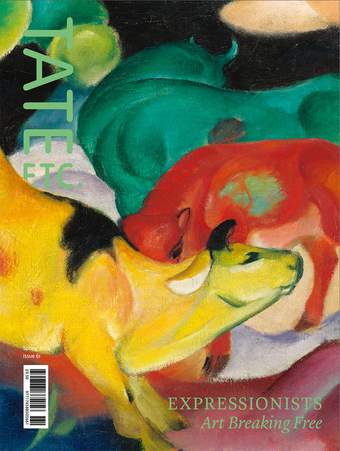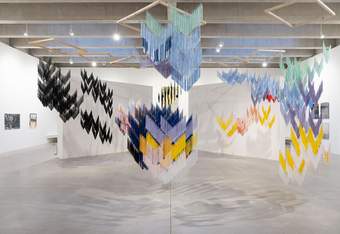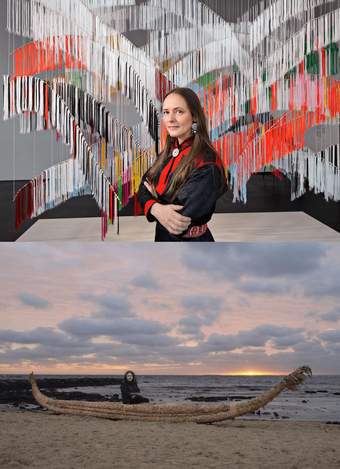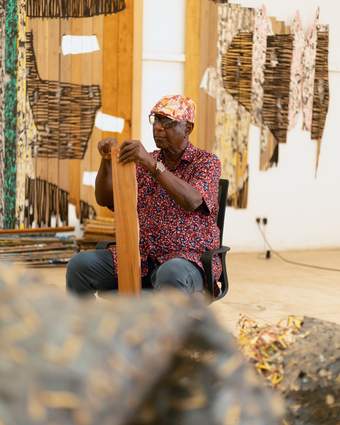
Outi Pieski in Porthmeor Studios, St Ives, photographed by John Hersey, January 2024
© DACS 2024. Photo © John Hersey
ELLEN MARA DE WACHTER Your exhibition at Tate St Ives is the largest international presentation of your work to date. What does it mean to you to have your work shown internationally at this time?
OUTI PIESKI The exhibition aims to raise questions about ancestral return and indigenous people’s rights, as well as relationships between humans, animals and lands. I think that these are major issues in current times, and they are connected to the climate crisis.
EMDW Have you discovered connections between these interests and Cornwall during your month-long residency at Porthmeor Studios in St Ives?
OP Cornwall is a new area for me. Since my artistic practice is inherently linked to Sápmi land – made for and originating from the land where I live – it feels a bit different to be making work here. But the lands here are really present in everyday life, and in that sense it’s easy to be grounded here. And I have felt some similarities to my home in Sápmi, extending to the history of this area – for example, in relation to the revived Cornish language. I feel privileged that we still have our own mother language, Northern Sámi, which I can speak and that is alive and embedded in the land.
EMDW Both your paintings and your sculptural installations involve the Sámi tradition of duodji, which is often translated as ‘craft’, but that term doesn’t quite account for everything the practice is and does. Could you explain duodji and how you use it?
OP Duodji is a holistic concept that preserves Sámi philosophy, values and spirituality, and connects them with practical and traditional skills. There is power in craft or duodji and also in art. This power is in the material itself, and comes from how it is collected and found, and from the person who has used it and put love and energy into it. I often incorporate some kind of craft element in my paintings, as you say. I want to point out the materiality in painting, because, according to a modern interpretation, my painting seems abstract and as if it represents something that does not exist. But I think the power that is naturally imbued in a painting is also a subject in itself.
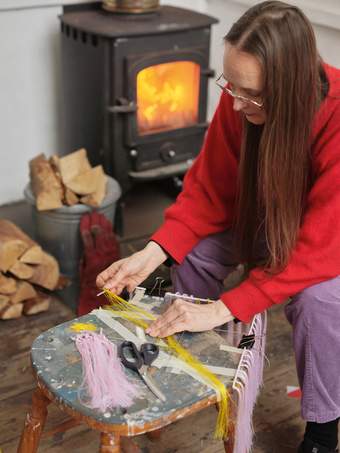
Outi Pieski in Porthmeor Studios, St Ives, photographed by John Hersey, January 2024
© DACS 2024. Photo © John Hersey
EMDW The somatic (or bodily) aspect of duodji is also important. What does it feel like for you when you are doing duodji?
OP It brings out things that we hold in our bodies, like intergenerational traumas, but with this also comes the wisdom of our ancestors. Often when you are learning or doing duodji – for example, working with reindeer hide to make traditional shoes, stitching cloth hats, or knotting thread to make the tassels that fringe our shawls – your hands show you how to do it. Your hands remember, even though you weren’t aware you knew how. All cultures have this in some respect: we hold collective knowledge in our selves. I also love the ritual aspect of duodji-making. In my installations, I use a lot of Sámi shawl tassels. It’s a simple act to make the tassels and knots – the process is very repetitive and natural, and it produces a feeling similar to the one you get when walking, skiing and gathering gifts from nature. It’s like a practical way of synchronising with the rhythm of other living entities. And while you are doing a specific duodji, you know that there are other people who have made, and are making, the same things, which makes it a collective form of memory and creativity.
EMDW Your tassel installations – for example, Beavvit – Rising Together 2019 – use duodji to create spaces which people can enter and then be surrounded by the work. What prompted your move from painting to installation?
OP Beavvit – Rising Together is inspired by the idea of a gathering of good friends, and how this flocking together can heal individuals in the common struggle against colonial history. Because I have a background as a painter, I think of my installations as being like three-dimensional paintings that you can enter and experience as a protective surrounding – the kind of thing you might find in the forest or elsewhere in the land. So, in a similar way to when you are together with other Sámi people dressed in the traditional Sámi dress, the gákti, it creates a kind of nomadic monument – because we, the Sámi people, don’t have any ‘monuments’ in the usual sense. In pictures, the Sámi region of Sápmi is often portrayed as an area of wilderness or a no man’s land, but it is actually full of the marks of people living in their area and ancestral knowledge about how to live with the land. It even contains ancestors themselves – in the form of mountains, rivers, soil – that continue to provide knowledge in the present. That is an important thing I want to bring out through my works. That interconnectedness is a focal point in the Sámi world: being connected to others, to family – we have really big families – and all kinds of other connections between people and lands.
EMDW What role does collaboration have in your art?
OP As a Sámi artist, I feel that many other Sámi artists or practitioners or activists are working with the same issues, and so we are making collaborative work even though we are working separately, on our individual things. Duodji is a collective way of creating and we follow traditional rules. It can be said that duodji is a language. There are specific messages in Sámi clothing, for example, that we want to keep alive and carry on communicating. These messages hold the deep knowledge of our ancestors and Sámi philosophy. But they are also in some way hidden in the clothing or in the duodji details, because we needed to hide so much during the period of colonialism, which has been ongoing for centuries but was most intensive from the 17th century and extended into the early 20th century. A person who knows the language will understand what the duodji is saying, which makes it a collective way of communicating, as well as creating.

Outi Pieski in Porthmeor Studios, St Ives, photographed by John Hersey, January 2024
© DACS 2024. Photo © John Hersey
EMDW You collaborated with Finnish archaeologist Eeva-Kristiina Nylander on the project Máttaráhku ládjogahpir – The Foremother’s Hat of Pride 2017–21, which revives the ládjogahpir, a traditional Sámi headdress. What motivated this project?
OP We wanted to investigate the colonisation of the minds and bodies of Sámi women through one specific object, the ládjogahpir hat. (However, as we see it, these hats are also subjects rather than simply objects.) In the mid-19th century, a pietistic Lutheran movement called Laestadianism started in Sápmi, and claimed that the cloth, horn-like form that crowns this kind of hat was in fact the devil’s horn and had to be burned. This story shows how heteropatriarchal culture came to Sápmi and demonised Sámi women’s power, spirituality and sexuality. We held duodji workshops with other Sámi women and together we made the ládjogahpir hat live again. In this way, we have started to use it as a tool to come together and talk about gender justice in Sámi society.
EMDW How do you feel when you wear the ládjogahpir?
OP Well, that is also a somatic experience. It brings with it a specific attitude – and, as I said, nowadays it’s a symbol for decolonial feminism in Sámi society. The ládjogahpir hat is one example of the importance of repatriating indigenous belongings. Sámi belongings are scattered across European museums, including one ládjogahpir in the British Museum collection. It is extremely important to get these belongings back.
EMDW You use the term ‘rematriation’ for what you are doing in this project. Can you say more about this?
OP With Eeva-Kristiina Nylander, I claim that re-matriation starts where repatriation does not reach. It addresses the failure to bring history out of gendered perspectives and it acknowledges women’s history and value, also paving the way for non-binary and queer stories. Rematriation acknowledges the importance of non-binary, queer and overlooked histories and knowledge to return, and of bodily connections between people and land, and people and animals. It also helps us to re-remember knowledge that our ancestors held. Because of colonialism and the assimilation of Indigenous peoples into dominant cultures, many things have been lost and need to be relearned and strengthened. Without direct connection to belongings, such as the ládjogahpir, we are without history, and every nation has the right to their own history. Re-remembering processes is crucial for our cultures to survive and go on.
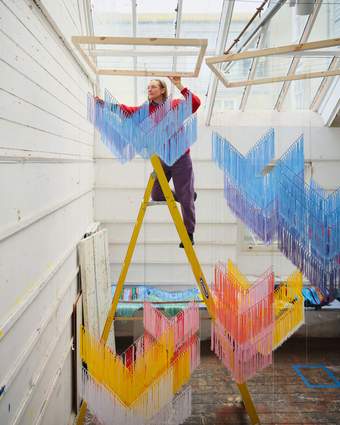
Outi Pieski in Porthmeor Studios, St Ives, photographed by John Hersey, January 2024
© DACS 2024. Photo © John Hersey
EMDW You grew up in Helsinki, so how did you re-remember your Sámi heritage and learn the truth about events under colonialism?
OP I spent the holidays in my father’s village of Dálvadas in Ohcejohka in Sápmi land before moving there permanently as a young adult. I grew up with messages from dreams and nature, such as signs from the birds, which are part of everyday life here. But I realised that there was something special in my experiences compared to those of my friends in Helsinki. It’s so sad how quickly assimilation happens – it takes just one generation. It’s easy to forget, but it’s so hard to get that knowledge back. My generation is often thought of as the lost generation, and so many of us have parents who have not spoken the Sámi language to us and not passed on a sense of value for the tradition they hold. I have needed to learn the language better as an adult. It’s big work and takes a lifetime to learn it again properly. With this also comes a pressure to value the Sámi way of living and being all the time. This kind of ethno-stress is quite common in Sámi society. But on the other hand, it’s really wonderful and positive that I belong to a family and to a specific land.
EMDW Are you seeing a shift in your own life regarding how Indigenous rights are being recognised? Are you optimistic about the direction of travel?
OP We are living through really difficult times in the Arctic, because we are in a rare area where the natural resources have not yet been taken from the land. And now we are also living in an era of green colonialism. For example, there is the Fosen onshore wind farm in the Southern Sápmi in Norway, where huge numbers of wind turbines have been built on ancestral reindeer-herding areas. The Norwegian government was taken to court and the reindeer herders won, but the illegal windmills have not been taken down. The climate crisis is used to justify the continuation of the project, but it is badly affecting traditional livelihoods in the area. For the Sámi society where I live, close to the borders of Finland and Norway, it’s a frightening situation. A new wind turbine project is currently planned for construction on Rástegáisa, a sacred mountain. But there is hope in the form of a growing protest movement, which has already become huge.
EMDW Your landscape paintings don’t seem to be representations of the land exactly, but something else – maybe evidence of a spiritual connection to place, or even an extension or part of the original landscape. What are these paintings for you?
OP In the Sámi world or philosophy, everything is interconnected. Spirituality is connected to practical things, like when you are taking in fishing nets from the river. Nature is not something other; it’s not something that exists in opposition to myself – to be seen or observed. It’s something that is lived and walked through, and it’s always active. I like to use acrylic medium mixed with pigments, which creates a really fluid painting material. This helps because the painting sort of creates itself – it has its own nature, and then I can collaborate with that.
I’m not interested in the Romantic tradition of landscape painting. I like to propose the intimacy, the appreciation and the miracle of the landscape, but without being sentimental. My paintings are the places I have been, and they appear the way they do because I have been in those places. Sometimes I may not even know what place I have been painting exactly. But later, in the forest, I might say to myself: Oh yes, now this was the place. And I feel really happy that, through this process of learning the homelands, the land is in me. The paintings are signs that this is happening.
In these paintings, details are also really important. Such as in these lands, here in Cornwall: you can see far away, over big distances, but at the same time you’re surrounded by vegetation and things that appear really detailed. The land is talking through the smallest plants and creatures. I want these details in the paintings to invite your eyes to move, because when you are outdoors, your gaze moves freely – you forget yourself and are just free.
Outi Pieski, at Tate St Ives until 6 May. Curated by Anne Barlow, Director with Giles Jackson, Assistant Curator, Tate St Ives. Supported by Jane and Aatos Erkko Foundation with additional support from the Outi Pieski Exhibition Supporters Circle, Tate Americas Foundation and Tate Members.
Ellen Mara De Wachter is a writer based in London. Her latest book, More Than the Eyes: Art, Food and the Senses is published by Atelier Éditions this spring.
Outi Pieski is an artist based in Ohcejohka (Utsjoki), Finland.

